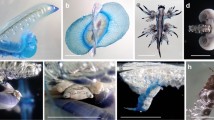Abstract
Saxidomus giganteus (butter clams), are known to sequester diet-derived paralytic shellfish toxins (PST), highly potent neurotoxins, in their siphons. Captive staghorn sculpins (Leptocotus armatus), a marine fish species known to crop bivalve siphons, developed a significant aversion to siphons from toxic but not non-toxicS. giganteus following a single conditioning feeding of toxic siphon tissues. Control fish showed no aversive response to siphons from non-toxicS. giganteus during 11 feeding sessions over 56 d. Aversive and non-aversive behavior varied with the toxicity of the siphons, but not with the geographic origin of the clams. Both experimental and control fish ate freely and showed no aversion to siphons from toxic littleneck clams (Protothaca staminea). Littleneck clams, unlikeS. giganteus, retain PST in their visceral mass but not in their siphons. Both toxic and non-toxicS. giganteus extended their siphons significantly more often and higher above the sediment surface during dark hours, but toxicS. giganteus extended their siphons higher than non-toxic individuals. These results support the hypothesis that siphon-nipping by fish may have selected for the retention of PST in butter clam siphons as a chemical defense.
Similar content being viewed by others
Literature cited
Bayer, R. D. (1985). Shiner perch and Pacific staghorn sculpins in Yaquina Estuary, Oregon. NW Sci. 59: 230–240
Blogoslawski, W. J., Stewart, M. E. (1978). Paralytic shellfish poison inSpisula solidissima: anatomical location and ozone detoxification. Mar. Biol. 45: 261–264
Brower, L. P. (1984). Chemical defense in butterflies. In: Vane-Wright, R. I., Ackery, P. R. (eds.) The biology of butterflies. Princeton University Press, Princeton, p. 109–134
Brower, L. P., Fink, L. S. (1985). A natural toxic defense system: cardenolides in butterflies versus birds. Ann. N. Y. Acad. Sci. 443: 171–188
Brower, L. P., Nelson, C. J., Seiber, J. N., Fink, L. S., Bond, C. (1988). Exaptation as an alternative to coevolution in the cardenolide-based chemical defense of monarch butterflies (Danaus plexippus L.) against avian predators. In: Spencer, K. (ed.) Chemical mediation of coevolution. Academic Press, San Diego, p. 447–475
Chai, P., Srygley, R. B. (1990). Predation and the flight, morphology, and temperature of neotropical rain-forest butterflies. Am. Nat. 135: 748–765
Halstead, B. W. (1978). Poisonous and venomous marine animals of the world. Darwin Press, Princeton
Kvitek, R. G. (1991). Sequestered paralytic shellfish poisoning toxins mediate glaucous-winged gull predation on bivalve prey. Auk 108: 381–392
Kvitek, R. G., Beitler, M. K. (1988). A case for sequestering of paralytic shellfish toxins as a chemical defense. J Shellfish Res. 7: 629–636
Kvitek, R. G., Beitler, M. K. (1991). Relative insensitivity of butter clam neurons to saxitoxin: a pre-adaptation for sequestering paralytic shellfish poisoning toxins as a chemical defense. Mar. Ecol. Prog. Ser. 69: 47–54
Kvitek, R. G., DeGange, A. R., Beitler, M. K. (1991). Paralytic shellfish poisoning toxins mediate sea otter feeding behavior. Limnol. Ocean. 36: 393–404
Peterson, C. H., Quammen, M. L. (1982). Siphon nipping: its importance to small fishes and its impact on growth of the bivalveProtothaca staminea (Conrad). J. exp. mar. Biol. Ecol. 63: 249–268
Quayle, D. B. (1969). Paralytic shellfish poisoning in British Columbia. Bull. Fish. Res. Bd Can. 168: 1–69
Shumway, S. E. (1990). A review of the effects of algal blooms on shellfish and aquaculture. J. Wld Aquacult. Soc. 21: 65–104
Sullivan, J. J. (1988). Methods of analysis for DSP and PSP toxins in shellfish — a review. J. Shellfish Res. 7: 587–596
Twarog, B. M., Yamaguchi, H. (1974). Resistance to paralytic shellfish toxins in bivalve molluscs. In: LoCicero, V. R. (ed.) Proc. 1st. int. Conf. tox. Dinoflagellate Blooms. Massachusetts Science and Technology Foundation Wakefield, Mass., p. 381–393
Vogel, S. (1981). Life in moving fluids. Princeton University Press, Princeton
White, A. W. (1981). Sensitivity of marine fishes to toxins from the red-tide dinoflagellateGonyaulax excavata and implications for fish kills. Mar. Biol 65: 255–260
White, A. W., Fukuhara, O., Anraku, M. (1989). Mortality of fish larvae from eating toxic dinoflagellates or zooplankton containing dinoflagellate toxins. In: Okaichi, T., Anderson, D. M., Nemoto, T. (eds.) Red tides biology, environmental science, and toxicology. Elsevier, New York, p. 167–180
Williams, G. C. (1966). Adaptation and natural selection. Princeton University Press, Princeton, New Jersey
Yamamori, K., Nakamura, M., Matusi, T., Hara, T. J. (1988). Gustatory responses to tetrodotoxin and saxitoxin in fish: a possible mechanism for avoiding marine toxins. Can. J. Fish. aquat. Sciences 45: 2182–2186
Author information
Authors and Affiliations
Additional information
Communicated by M.G. Hadfield, Honolulu
Rights and permissions
About this article
Cite this article
Kvitek, R.G. Paralytic shellfish toxins sequestered by bivalves as a defense against siphon-nipping fish. Mar. Biol. 111, 369–374 (1991). https://doi.org/10.1007/BF01319408
Accepted:
Issue Date:
DOI: https://doi.org/10.1007/BF01319408




